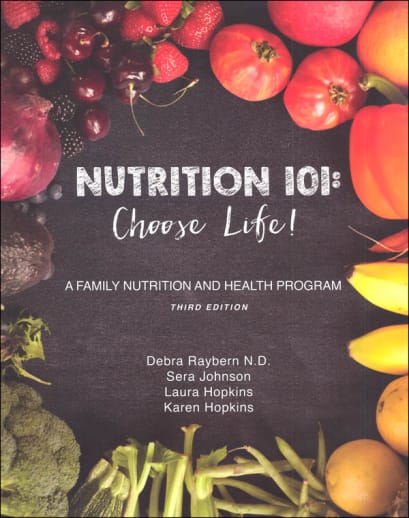When you're homeschooling it makes sense to study nutrition as a family, right? After all, you probably are all preparing and eating the same meals, and meal planning and shopping may even be cooperative efforts (if not, Mom is probably overworked!). Nutrition 101: Choose Life! was written for homeschooling families by a team of four moms (including two homeschool moms) to educate families about the relationship between our bodies and the food we eat. It's a unique book in that it is part textbook, part reference, and part cookbook. It's also a beautiful book, with glossy, full-color pages and good quality illustrations and photos. Finally, it's also biblically-based with plentiful Scripture references (KJV version) and a constant reminder that we are charged with maintaining the incredible body systems that God endowed us with. The course is divided into six main units, covering the major body systems: the brain and nervous system; digestive system; respiratory system and the senses; muscular and skeletal systems; cardiovascular and immune system; and the endocrine system and emotions. Units are further
divided into four chapters, each designed to be completed in about a week. The authors provide a suggested daily schedule; however, you can easily adapt this to fit your needs. Each body system studied ties into a study of a particular nutrient or nutrients that you are encouraged to work into your diet, and to this end, quite a few healthy, whole-food recipes are included. The end of the book is also literally packed with a huge assortment of appendices (including lots of helpful charts!) and a thorough answer key for the activities. Each chapter includes text for reading, discussion questions, activity suggestions for elementary and secondary students, additional resources for further exploration, a "power recipe" and related activities. Typically, you'll first read about a body system, learn its function and all of the major parts, then continue on to learn about common health issues related to that body system and their causes. This is usually followed up by a closer look at a particular nutrient or group of nutrients that is beneficial to that particular body system.
The "Power Recipe" (and associated list of activities) for each chapter is usually related to one of the featured beneficial nutrients. For instance, Unit 3, Chapter 4 is on the eyes. The first part of the chapter examines the parts of the eye and how the eye works. Then you'll read about eye sight issues including pink eye, sties, cataracts, glaucoma, presbyopia and age-related macular degeneration. Next you examine nutrients that help maintain eye health including antioxidants, beta-carotene (to be converted to Vitamin A), lycopene, anthocyanosides, DHA, lutein, zeaxanthin and others. Several foods that have an adverse effect on eyesight, including trans fatty acids and processed foods are also discussed here. Discussion questions include how to protect your eyes, what foods are bad for your eyes, and applying what you've read about the eye to a particular Scripture. The activities are hands on and include spending time blindfolded (elementary level), finding a percentage of family members that wear glasses or contact lenses (elementary), explaining the difference between an ophthalmologist and optometrist (secondary) and discussion other meanings of vision (secondary). The "Power Recipe" focuses on carrots as an ingredient for a fresh carrot juice smoothie, and several carrot and juicing activity suggestions round out the recipe activities.
The format of this course makes it extremely easy to use as a family. You can assign everyone to read (or read aloud) the text, and then get back together for the discussion questions. Discussion questions tend to be fairly easy if you've read or heard the chapter, so everyone would be able to participate here, maybe even over dinner! Depending on the ages of your students and the time allotted, you will probably want to pick and choose activities to assign. The featured "Power Recipe" would be easy to incorporate into a meal and the related activities may naturally fit into meal preparation.
While this course is packed with excellent information, recipes and activities, there are a few items I should note. First of all, for all of the anatomical information and vocabulary covered, there are no tests or worksheets to reinforce the reading. The focus of the course is really to educate families and encourage them to change their eating habits, not provide easily graded assessments! However, this would be fairly easy to supplement if desired. The recipes and foods you are encouraged to try are healthy whole foods with low to no sugar, whole grains and possibly some ingredients you haven't met before. If you've never explored your local health food store, you'll find quite a few reasons to visit it now! You'll also find that there are some pretty strong opinions presented here, for example, when discussing toxins found in household cleaners and personal care products, or when examining specific nutrients or supplements-including extensive recommendations for Young Living Essential Oils. You will likely come across something here that you may disagree with, based on your own beliefs, or at least something that will make you stop and think (or perhaps do some further research on). Lastly, I did notice a couple of typos in perusing this resource, which was disappointing in such an otherwise appealing book. Whether you are looking for a nutrition course or trying to educate yourself or your family on why you should eat healthier foods, this is definitely a resource to consider. It's one that you'll want to leave on the shelf long after you've "finished" the course, as you'll be referring to it again and again! 448 pgs, pb. Jess/Deanne

